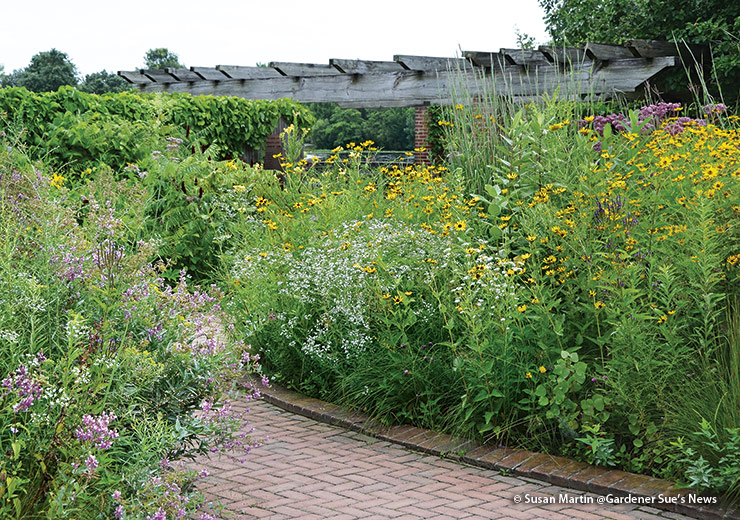
Diversity of the prairie
Long before central North America was settled and developed, large swathes of verdant prairies teeming with diverse flora and fauna thrived there. Expansive grasslands existed from Canada south to Texas, and from Indiana west to Colorado. Though few original prairies still exist, gardeners across America have begun to take action to restore prairie plantings right in their own backyards.
Why grow prairie plants?
Prairie gardens, especially more expansive and interconnected ones, offer habitat, food and refuge for vital pollinator and wildlife populations. Also, compared to turf grass, mature prairie plantings require less water, fertilizer, fossil fuels and effort to maintain. That’s because many native prairie plants are naturally drought tolerant, pest resistant and adaptable to low-nutrient soils.
Though original prairie plant communities were comprised of 60 to 70 percent grasses and sedges, urban prairie restorations of all sizes often limit that amount to 30 to 40 percent, leaving more room for wildflowers. Using fewer grasses helps in maintenance, since some may dominate by spreading too rapidly. Keep reading to find out which grasses and sedges could form the backbone of your prairie garden; then I’ll share lots of wildflowers.
You Might Also Like:
Tips for Choosing Native Plants for Your Garden
How to Plant Native Plants in Natural Layers
Helpful Gardening Videos
Getting started with native prairie plants
By their nature, prairies are large, open expanses of land where native plants spread easily and abundantly. If you choose to grow native species in your own prairie garden, you will need plenty of room at least a few acres for the plants to spread and achieve the “wild” look you are going for. If you are limited on space, you can still get many of the same benefits by growing a micro prairie (scroll on to learn more about that below) using the native cultivars I’ve called out as “Micro Prairie Plant Picks”. They often take up less room and are not rampant spreaders.
Sources for prairie plants and seeds
- Mail Order Natives, 850-973-7371
- National Seed Supplier Directory
- Prairie Moon Nursery, 866-417-8156
- Prairie Nursery, 800-476-9453
- Rare Find Nursery, 732-833-0613
What is a micro prairie?
Good news! You don’t need to own acres of land to grow a micro prairie. “Some people do not realize they have the power to sequester carbon, provide habitat for wildlife, prevent erosion, and clean water by choosing to replace the norm — their non-native lawn or flowerbeds — with a prairie,” said John Hart Asher, environmental designer at the Lady Bird Johnson Wildflower Center of Austin, Texas.
Micro prairies are smaller urban gardens that include a diverse group of native species and cultivars. There are no rules for size. You might choose to devote one section of your property to this kind of planting and team up with a neighbor who could develop a native garden adjacent to yours. By interconnecting micro prairies throughout neighborhoods, you can create extended spaces for pollinators and wildlife to prosper.
Native prairie grasses
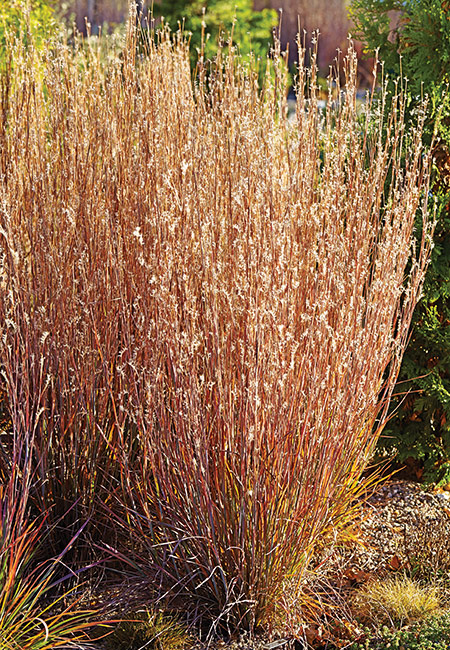
Little bluestem (Schizachyrium scoparium)
One of the most iconic grasses of North American tallgrass prairies is little bluestem. You might find songbirds feasting on its seeds and caterpillars of skipper butterflies feeding on its foliage. Since it is typically grown from seed, it can be variable in size and color. Generally, expect it to form an airy clump of very narrow, blue-gray to bright green foliage. The rich copper, burgundy and red tones you see here dominate in fall when small, fluffy seeds dot the top half of the stems.
Little bluestem combines beautifully with wildflowers like gloriosa daisy and purple coneflower, which prefer similar growing conditions. It thrives in low nutrient soils and dry conditions and is deer resistant.
Micro prairie plant pick
‘Standing Ovation’ little bluestem stands more upright than many, and adapts more easily to average garden soils.
Type Grass Blooms Small tufts of tan seeds from late summer to early fall Light Full sun Soil Dry to average, sandy; not recommended for heavy clay Size 2 to 4 ft. tall, 2 to 3 ft. wide Cold hardy USDA zones 3 to 9
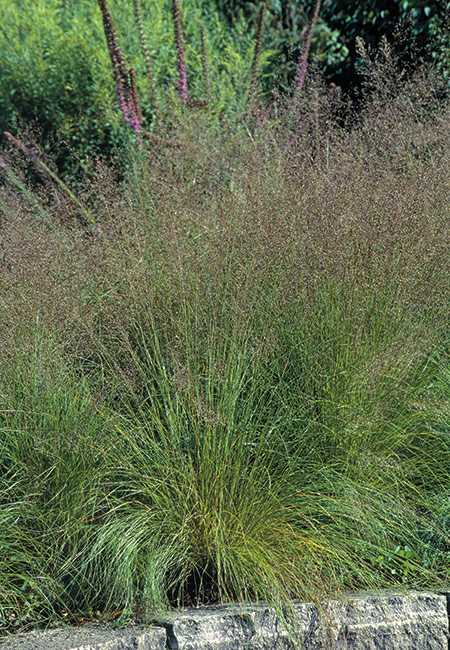
Prairie dropseed (Sporobolus heterolepis)
The graceful fountainlike, non-spreading habit of prairie dropseed, a native prairie grass, makes it a popular choice for both formal and informal gardens, where it is often planted as an edging or ground cover. Its glossy green, finely textured leaves form a dense clump that can grow for decades without the center dying out or needing to be divided. Long, arching stems carry unusual seed panicles whose fragrance has been described as resembling cilantro or roasted nuts. Its fall color ranges from gold to coppery orange.
A key advantage of this grass is its adaptability to most kinds of soils, from rocky to clay, fertile or infertile, and moist or dry. Deer aren’t interested, but birds enjoy its nutritious seeds.
Micro prairie plant picks
‘Tara’ was selected by native perennial expert Roy Diblik for its more compact shape and orange-red fall color.
Type Grass Blooms Airy tan seed panicles from late summer to fall Light Full sun Soil Dry to moist; tolerates most soil types Size 2 to 3 ft. tall and wide Cold hardy USDA zones 3 to 8
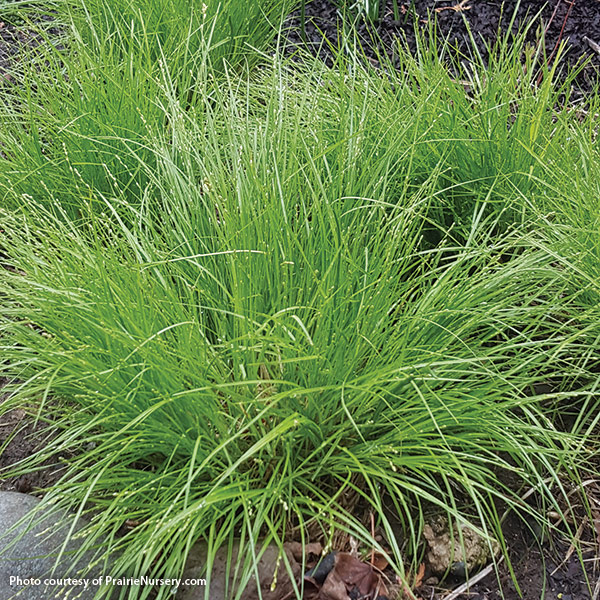
Rosy sedge (Carex rosea)
Sedges are one of the most diverse groups of native plants in North America, and as such, there is a species for every growing condition.
This is a woodland sedge that forms a beautiful, no-maintenance ground cover in the shade of deciduous trees. It can also be grown as an alternative to turf in shady spaces and mowed once per year in early spring. If your prairie garden has trees, you could grow this sedge under them where it will spread slowly, even in dry shade. Small starlike green seed pods provide additional interest.
Type Grass Blooms Green seed pods from early to midsummer Light Part shade to full shade Soil Dry to moist; tolerates most soil types Size 8 to 12 in. tall and wide Cold hardy USDA zones 3 to 8
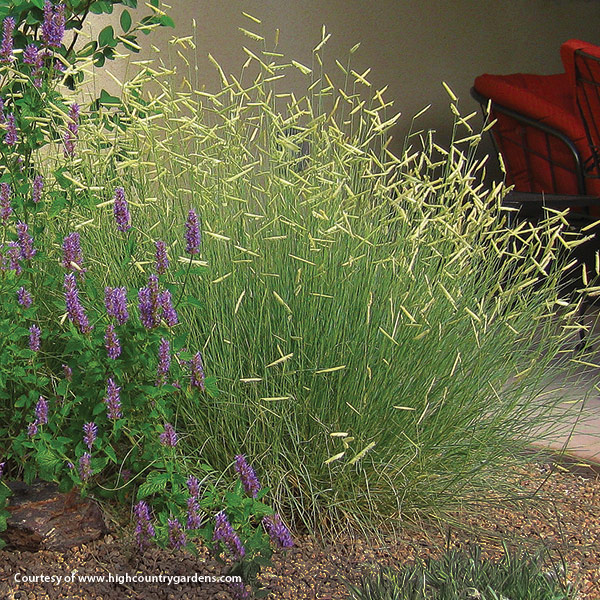
Blue grama grass (Bouteloua gracilis)
You’ll recognize this grass by its interesting horizontally displayed seedheads, which appear like tiny brushes or eyelashes at the tips of tall stems. They sway in the slightest breeze, bringing graceful movement to the garden. Birds enjoy the seeds all season long and the plant is a larval host to many types of skipper butterflies.
This is a very drought-tolerant, low-growing grass that can be planted close together as a ground cover or turf alternative. It can be mowed two or three times a season to 2 to 3 inches tall and tolerates a considerable amount of foot traffic. If you do use it as lawn, keep in mind that it is semi-evergreen in mild climates but will go winter dormant in northern zones.
Micro prairie plant pick
‘Blonde Ambition’ is a vigorous cultivar of blue grama grass that grows 2 to 3 feet tall and produces an abundance of ornamental seedheads.
Type Grass Blooms Eyelash-shaped, tan seed heads from early summer to fall Light Full sun Soil Dry to average; tolerates most soil types Size 6 in. tall (12 in. in bloom), 12 to 18 in. wide Cold hardy USDA zones 3 to 10
You Might Also Like:
Plants to Pair with Ornamental Grasses
Smart Gardening Videos | Garden Gate YouTube Channel
Drought-Tolerant Lawn Replacements
Native prairie flowers
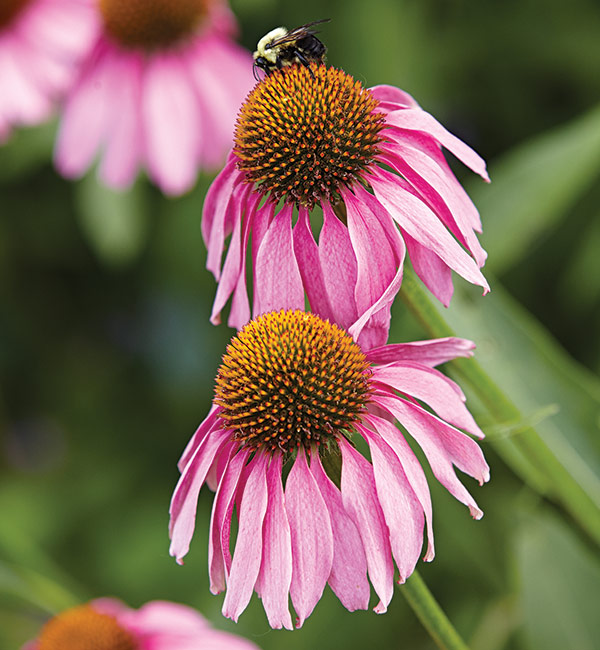
Purple coneflower (Echinacea purpurea)
Few native prairie plants have gained the level of botanical stardom that purple coneflowers enjoy. Cultivars in every color abound, but the native species has a graceful beauty all its own. It is easy and economical to grow from seed sown in fall, especially in colder zones where it benefits from several months of temperatures below 40 degrees F to ensure good germination rates.
Purple coneflowers are used to best effect in large masses paired with other non-aggressive wildflowers like gloriosa daisy. This species blooms pink with slightly drooping petals that don’t overlap much compared to fancier cultivars. Its domed, copper-orange cones provide the perfect landing pad for goldfinches, bees and butterflies.
Micro prairie plant pick
PowWow® Wild Berry is a shorter, fuller cultivar with vibrant rose-purple flowers. Plants grow 18 to 24 inches tall and 12 to 16 inches wide.
Type Perennial Blooms Pink-purple flowers with a copper orange cone from early summer to fall Light Full sun to part shade Soil Dry to average, well-drained soil Size 24 to 48 in. tall, 18 to 24 in. wide Cold hardy USDA zones 3 to 8
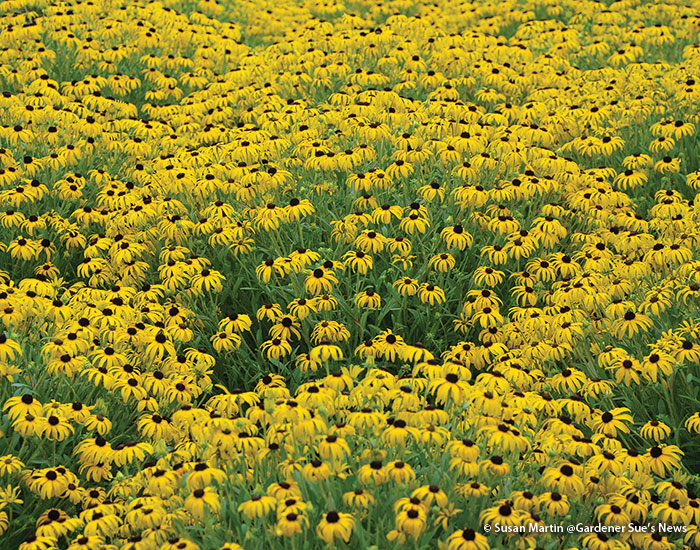
Gloriosa daisy (Rudbeckia hirta)
This golden beauty is one of the most prolific wildflowers in North America, naturally occurring in every Canadian province and U.S. state except Arizona and Nevada. It is a short-lived perennial, but it persists for many years because it self-seeds freely wherever it is happy.
Two species of butterflies — the bordered patch and gorgone checkerspot — make this wildflower their larval home; bees and birds are big fans, too. Because of its hairy stems and leaves, deer find gloriosa daisy to be a fuzzy mouthful they don’t enjoy.
Micro prairie plant pick
‘American Gold Rush’ is a longer lived hybrid that has similar hairy foliage but a fuller, rounded habit and excellent disease resistance. It grows 18 to 22 inches tall and 24 to 36 inches wide.
Type Perennial Blooms Golden, daisy-shaped flowers in early summer to fall Light Full sun to part shade Soil Dry to moist; tolerates most soil types Size 1 to 3 ft. tall and wide Cold hardy USDA zones 3 to 9
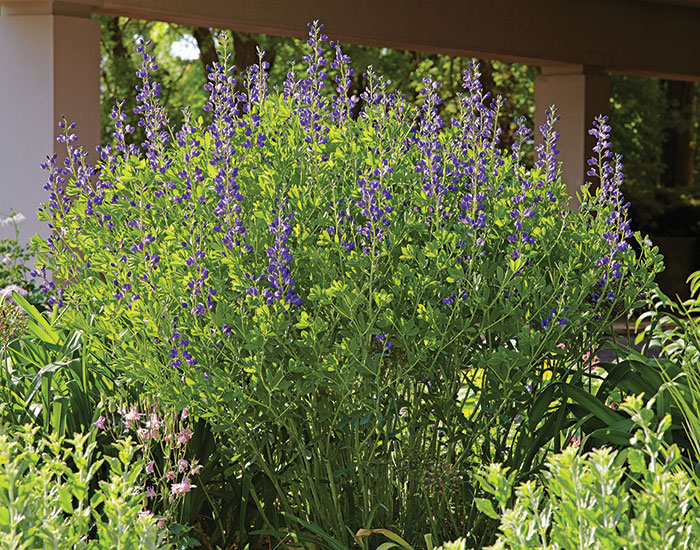
False indigo (Baptisia australis)
This extremely durable native prairie plant is one of the longest-lived perennials you’ll ever grow, typically lasting more than 50 years. Its deep tap root helps the plant easily survive drought conditions but also makes it very difficult to move once established, so some forethought is needed before you plant.
The species blooms with spikes of bright blue flowers, which are pollinated by native bees and bumble bees in late spring to early summer. Once they are fertilized, puffy seed pods develop in their place on the stem and age to a charcoal color, persisting into winter. There are many hybrids with different flower colors, from shades of blue to burgundy, pink, purple and yellow.
Micro prairie plant pick
‘American Goldfinch’ false indigo is a prolific bloomer with long, canary yellow flower spikes and a 2- to 3-foot-tall and 1- to 2-foot-wide habit.
Type Perennial Blooms Indigo blue flower spikes from late spring to early summer Light Full sun to light shade Soil Dry to average; tolerates most soil types Size 3 to 5 ft. tall and wide Cold hardy USDA zones 3 to 9
You Might Also Like:
Coneflower Growing Guide
Handy Gardening Books
6 Plants Birds Love
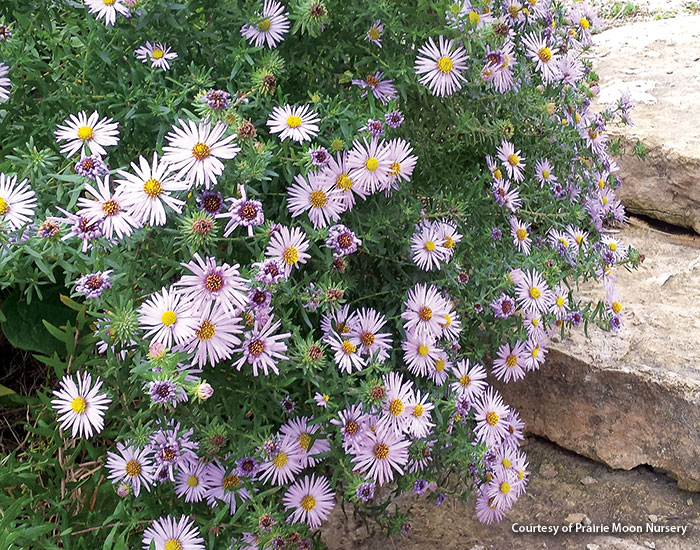
Aromatic aster (Symphyotrichum oblongifolium)
No autumn prairie would be complete without a few asters. Aromatic aster is one of the last species to finish blooming, so it continues to feed native bees, butterflies, moths and birds almost until the snow flies. Its light blue-purple flowers appear in clusters on airy, mounded plants with foliage that smells like balsam when crushed.
This aster spreads underground by stolons, so if you plant with less vigorous companions you will need to thin it regularly. Better to pair it with other spreading plants and let them duke it out for themselves.
Micro prairie plant pick
‘Raydon’s Favorite’ blooms more prolifically with darker flowers and is less aggressive. It grows 1 to 3 feet tall and wide.
Type Perennial Blooms Masses of light blue-purple flowers from late summer through fall Light Full sun to part shade Soil Dry to average, well-drained soils of all types Size 12 to 36 in. tall, 12 to 18 in. wide Cold hardy USDA zones 3 to 8
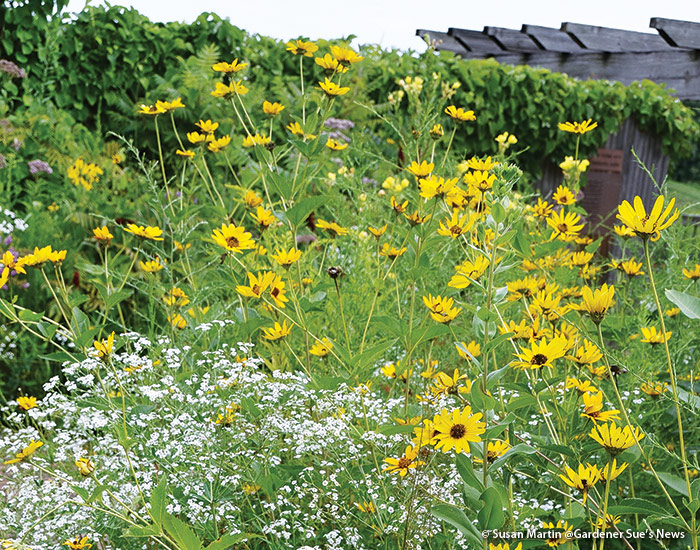
False sunflower (Heliopsis helianthoides)
Watch these golden yellow sunflowers usher in a lively parade of birds, butterflies, native bees and beneficial insects nearly all season in your prairie garden. If you cut them back after the first flush of flowers is spent, they will reward you with many more all the way into fall. Deadheading the plants like this will also keep them from reseeding too much.
This wildflower is incredibly easy to grow, tolerating any soil type and every moisture level except standing water. Let it reseed here and there and you’ll have plants for generations. It pairs beautifully with flowering spurge and wild bergamot in large masses.
Micro prairie plant pick
‘Tuscan Sun’ is a short, bushy selection that won’t reseed heavily and is resistant to powdery mildew. It grows 24 to 32 inches tall and 20 to 24 inches wide.
Type Perennial Blooms Golden yellow flowers from early summer into midfall Light Full sun to light shade Soil Dry to moist soils of all types Size 3 to 6 ft. tall, 1 to 4 ft. wide Cold hardy USDA zones 3 to 9
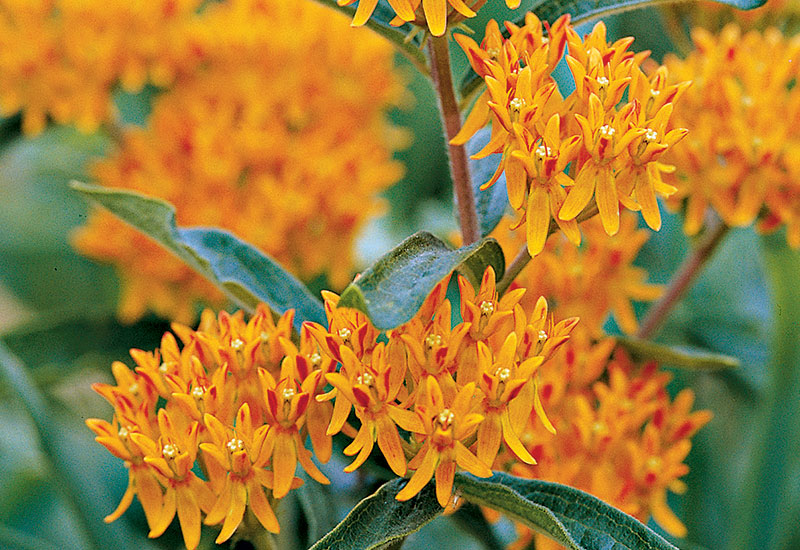
Butterfly weed (Asclepias tuberosa)
Butterfly weed is one of the many milkweeds, which are an essential component of prairies, as they host monarch butterflies and are an important food source for native bees. Hummingbirds may also stop by for a sip of nectar, but deer typically ignore it. Birds may snack on milkweed seeds when the puffy pods open in autumn.
There’s nothing quite like the blazing orange color of our native butterfly weed. It catches your eye from way across the garden when in bloom. Pair it with short grasses like prairie dropseed so it won’t be shaded or crowded out by other more aggressive plants.
Micro prairie plant pick
‘Hello Yellow’ butterfly weed is similar in stature but blooms with sunny yellow flowers.
Type Perennial Blooms Blazing orange flowers from early summer through late summer Light Full sun Soil Dry to average, sandy or loam soils Size 1 to 3 ft. tall, 1 to 2 ft. wide Cold hardy USDA zones 3 to 9
You Might Also Like:
Types of Milkweeds
Wildlife & Pollinator Garden Plans
DIY Butterfly Puddler
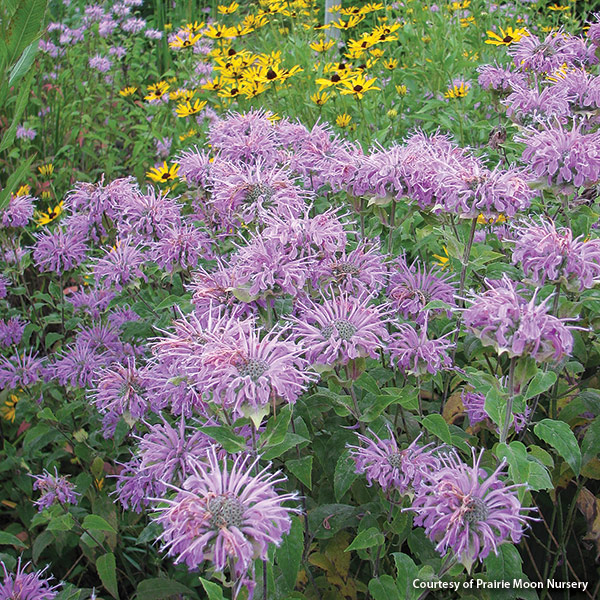
Wild bergamot (Monarda fistulosa)
This prolific wildflower occurs naturally across all of North America except California and Florida and prospers in a wide variety of soil types. It is a gold-star native in terms of providing nectar to numerous kinds of pollinating bees, butterflies, hummingbirds and hummingbird moths who find its fluffy, tubular, lavender pink flowers irresistible.
Wild bergamot is a member of the mint family and spreads easily by seed and rhizomes. It will grow best and be less prone to powdery mildew if you divide it every few years to thin out the clump. Though it can tolerate some drought, it prefers moist, well-drained soil.
Micro prairie plant pick
‘Claire Grace’ has better resistance to powdery mildew, slightly darker purple flowers and a sturdier habit. It grows 3 to 4 feet tall and 2 to 3 feet wide.
Type Perennial Blooms Lavender pink flowers from midsummer to early fall Light Full sun to part shade Soil Average to moist, well-drained soils of all types Size 2 to 5 ft. tall, 2 to 3 ft. wide Cold hardy USDA zones 3 to 8
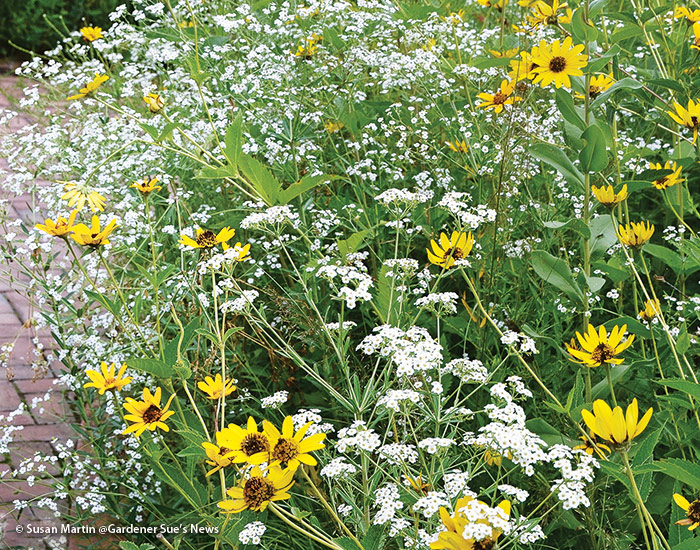
Flowering spurge (Euphorbia corollata)
This native perennial blooms with dainty white flowers over many months. It benefits numerous native bee populations and attracts beneficial insects that will help to naturally control pests in your home prairie.
Flowering spurge is a simple, single branched perennial that will reseed in and around other nonaggressive plants like the false sunflowers you see here, adding whimsy and movement to the garden. Though it may look delicate above ground, a strong tap root ensures its survivability in drought conditions. A milky sap running through its stems keeps deer and rabbits away but can be irritating to the skin, so wear gloves when pruning this plant.
Type Perennial Blooms Airy white flower panicles from midsummer into fall Light Full sun Soil Dry to average, well-drained soils of all types Size 24 to 36 in. tall, 12 to 18 in. wide Cold hardy USDA zones 4 to 8
















